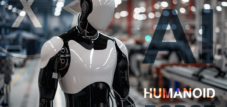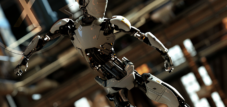Published on: April 15, 2025 / update from: April 15, 2025 - Author: Konrad Wolfenstein

The Humanoid Open Source Robot Reachy 2 of Pollen Robotics: Innovation and openness in Robotics-Image template: Pollen Robotics / Creative Picture: Xpert.digital
Future technology: The open source robot Reachy 2 in focus
Open source hits robotics: How Reachy 2 shifts the borders
Reachy 2 is an advanced open source of humanoid robots, which with its unique design and versatile skills redefines the world of robotics. This latest generation of the humanoid robot developed by Pollen Robotics combines innovative technology with an open source philosophy and thus opens up new opportunities for research, development and practical applications.
Suitable for:
- The AI-controlled robotics and humanoid robots: hype or reality? A critical analysis of the market maturity
The story of Reachy and Pollen Robotics
Pollen Robotics was founded in 2016 by two former inria researchers, Matthieu Lapeyre and Pierre Rouanet, in Bordeaux, France. The company initially focused on tailor -made robotics projects for artistic and cultural installations. The development of Reachy took shape in 2019 when the intern Augustin Crampette developed a bio-inspired joint system called “Orbita”, which was able to imitate human joint movements with high precision.
The first Reachy robot made its debut at CES 2020 in Las Vegas and immediately fascinated visitors with its liquid, natural movements and interactivity. A crucial moment in the development history of Reachy was the participation in the international robotics competition Ana Avatar Xprize in 2022. For this competition, the team had to improve the robot's skills in terms of robustness and payload, which led to working with the engine manufacturer Maxon. Despite the competition from established competitors with significantly larger budgets, Pollen Robotics achieved second place - a success that paved the way for the development of Reachy 2, which was launched in October 2024.
The latest version, Reachy 2, was presented at the CES in early 2025, where the company announced that 100 robots in 20 countries worldwide are already in use.
From research to reality
"With pollen Robotics, we are proud to offer the only modular, open source humanoidic robotic solution that meet today's market requirements and at the same time can anticipate future progress," says Matthieu Lapeyre, CEO of pollen Robotics. This vision of the company is reflected in its approach: "We build accessible and open source technologies for the real world with a focus on robot manipulation".
Technical features and skills
Reachy 2 is specially designed for the development of embodied AI and real applications and offers impressive technical properties that make it a powerful tool for different areas of application.
Anatomy and specifications
With a height of 166 cm and a weight of around 32-50 kg (depending on the configuration), Reachy 2 roughly corresponds to an adult's proportions. The robot has a total of 21 degrees of freedom (DOF), which are distributed as follows:
- 7 DOF for every arm (14 DOF overall)
- 1 DOF for every gripper (2 DOF overall)
- 3 DOF for the neck
- 1 DOF for each antenna (2 dof as a whole)
In their dimensions, proportions and movements, the bio-inspired arms are similar to those of an adult human arm. A single arm can lift objects up to 3 kg and manipulate with considerable skill. The robot can move at a recommended speed of 3.6 km/h (maximum 9 km/h) and has an operation time of around 8 hours per load.
Advanced sensors and computing power
Reachy 2 is equipped with the latest sensors, including:
- Two 1080p@30FPS cameras with a motorized zoom in the head (field of vision 65 ° to 125 °)
- Efforters in the Greiben
- Hall sensors and IMU on every wheel of the mobile base
- RP Lidar S2
The heart of the computing power is an internal computer with Intel i5 dual-core 2.1 GHz processor, 8 GB DDR4-RAM and 256 GB SSD memory. In addition, the robot has a embedded TPU (Google Coral) for machine learning, which ensures seamless compatibility with modern AI frameworks.
The Orbita system: key to natural movements
One of the main innovations of pollen Robotics is the patented Orbita joint system, which is available in two versions for different needs:
- Orbita 3D is used for the wrists and the neck and enables harmonious and smooth movements with a wide range with its three degrees of freedom
- Orbita 2D is integrated in the elbows and shoulders, articulated via two degrees of freedom and is designed to wear loads of up to 3 kg
Modular construction and configurations
One of the outstanding properties of Reachy 2 is its modularity, which enables the robot to adapt to various applications. The robot is available in four main configurations:
- Reachy 2 Dual Arm + Mobile Base
- Reachy 2 single arm + mobile base
- Reachy 2 dual arm
- Reachy 2 single arm
The mobile basis offers access to more applications and a larger work area. It is characterized by a simple navigation with three omniwheels, a cylindrical structure, many sensors and a lidar.
Teleoperation and VR control
A particularly innovative function of Reachy 2 is the possibility of telephoto surgery. With VR equipment, an operator can control the arms, hands and head of the robot in real time and see through Reachy's cameras to interact with the surroundings. This function not only enables remote control, but also the “teaching” of new movements, which the robot can later reproduce autonomously. With a glass-to-glass latency of only 125 ms, the system offers an impressive reaction speed that makes it ideal for remote operations, research and AI data acquisition.
Open source philosophy and development environment
The open source nature of Reachy 2 is a central pillar of identity of pollen Robotics. By publishing the plans and resources, the company in the global community offers the opportunity to adapt and enrich the platform.
Programmability and ROS2 integration
Reachy 2 is completely programmable with Python and is based on ROS2 FOXY, which offers an open and flexible programming environment for researchers and developers. This enables the integration of own algorithms and the enrichment of the software, which makes the robot an ideal platform for researching and developing new technologies.
"We have designed Reachy as a platform: researchers can integrate their own algorithms and developers can enrich the software," explains Elsa Kervella, sales and marketing director at Pollen Robotics.
Collaborative innovation
The collaborative philosophy allows Reachy 2 to be part of a constantly developing ecosystem. An example of this is the collaboration with Hugging Face, a reference for artificial intelligence models. This partnership enabled the development of the learning system integrated in the robot for telephoto surgery.
Areas of application and possible uses
Reachy 2 is designed for a variety of applications and addresses both the academic world and industry.
Research and academy
In renowned institutions such as EPFL, Cornell University or Carnegie Mellon University, Reachy is used for researching human-robot interaction and machine learning to expand the limits of artificial intelligence under real conditions.
Industry and service sector
In industry, the modularity of REACHY 2 enables adaptation to complex environments, be it for collaborative robotics tasks or specific simulations. Robot is also used in healthcare and retail.
A tool for AI development
According to Matthieu Lapeyre, founder of pollen Robotics, Reachy 2 is “a humanoid robot that was designed as a body for new generations of artificial intelligence”. This vision underlines the potential of the robot as a platform for the development and testing of new AI systems in real environments.
Current developments and future prospects
The presentation of Reachy 2 on the CES 2025 marks an important milestone in the development of the robot. With already 100 robots worldwide, the growing interest in this open, modular platform is evident.
Suitable for:
- Inference-as-a-Service (IaaS) for AI industrial solutions (Industry 4.0) – NVIDIA supports new inference service from Hugging Face
Partnerships and collaborations
Cooperation with various partners, including Maxon for engine integration and Hugging Face for AI developments, contributed to the continuous improvement of Reachy 2. These cooperation underline the commitment of pollen Robotics for collaborative innovation and the democratization of access to progressive robotics.
Modular, open source and innovative: What Reachy 2 makes unique
Reachy 2 represents significant progress in the development of humanoid robots. With its combination of advanced technology, modular construction and open source philosophy, it offers an accessible and flexible platform for researchers, developers and companies that work on the future of robotics and artificial intelligence.
The strengths of Reachy 2-its impressive human-machine interaction, its ability to manipulate a wide variety of objects, its telephoto operation via VR and its open development environment-make it a versatile tool for a variety of applications, from advanced AI research to practical, real manipulation tasks.
With its continuous improvements and the growing community of users and developers, Reachy 2 is well positioned in order to continue to play an important role in the development of humanoid robots in the future and to pave the way for new generations of robotics and AI systems.
Suitable for:
Your global marketing and business development partner
☑️ Our business language is English or German
☑️ NEW: Correspondence in your national language!
I would be happy to serve you and my team as a personal advisor.
You can contact me by filling out the contact form or simply call me on +49 89 89 674 804 (Munich) . My email address is: wolfenstein ∂ xpert.digital
I'm looking forward to our joint project.













